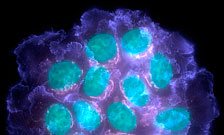How Cell Nuclei Squeeze into Tight Spaces
 As cells move throughout our bodies, they often have to squeeze through tight nooks and crannies in their environment, reliably springing back to their original shape. The structures involved in this process are still a mystery, but researchers in the Randall Division of Cell & Molecular Biophysics have found one protein responsible for giving a cell’s nucleus its durable, deformable nature. These results may explain the invasiveness of certain cancer cells. The findings have been published in the journal Developmental Cell.
As cells move throughout our bodies, they often have to squeeze through tight nooks and crannies in their environment, reliably springing back to their original shape. The structures involved in this process are still a mystery, but researchers in the Randall Division of Cell & Molecular Biophysics have found one protein responsible for giving a cell’s nucleus its durable, deformable nature. These results may explain the invasiveness of certain cancer cells. The findings have been published in the journal Developmental Cell.
‘The nucleus is the fattest organelle in the whole cell, and really needs to be squished if a cancer cell wants to metastasize throughout the body,’ says Maddy Parsons, Professor of Cell Biology, whose research group led the study. ‘There’s a really complex network of proteins that keeps the cell from buckling in on itself when it’s faced with a tight squeeze.’
Researchers pinpointed one protein responsible - fascin – that is known to be at unusually high levels in cancer cells. Originally, says Parsons, fascin was only thought to exist at the cell’s periphery as a “bundling protein,” where it binds and stabilizes spiky finger-like protrusions called “filopodia” at the cell’s plasma membrane. These structures allow the cell to sense its surrounding environment and pull itself through tissue. Now, the researchers have found that fascin also sits at the periphery of the nuclear envelope, binding to different structures there to add stability and prevent collapse.
‘All cells have a cytoskeleton made from lots of filaments of a protein called actin that give the cell it’s architecture, but without other proteins added on the skeleton will buckle under stress,’ says Parsons. ‘Proteins like fascin that bind onto this cytoskeleton add an element of stability and flexibility – it makes the cell more mechanically stable and able to rapidly respond to the environment to change shape. This data we have showing fascin at the nuclear periphery has opened up a new way of thinking about how this protein controls cancer cell movement’.
To investigate how fascin works at this site, in one set of experiments, the research team placed human cancer cells into a series of artificial microchannels, which are small devices with different pore sizes, ranging from large pores which a cell can easily maneuver through, to spaces as small as 2 microns wide, into which the cell can barely fit. By reducing intercellular levels of the fascin protein, they found that the cells were unable to squish their nucleus enough to fit into small channels. This suggests that cancer cells may use fascin to better navigate through different densities of tissues that they face during their invasion away from a solid tumour.
‘I think what we’re showing is that fascin has more than one important role in controlling cancer cell metastasis’ she adds. ‘Importantly, this is also revealing new ways that we can target fascin to block its function in cancer cells.’
Parsons and her team are still eager to find out what are the forces controlling fascin in cancer cells. ‘We’re really still in the dark about what proteins are controlling these different functions of fascin,” she says. “We still don’t know what proteins and signals are telling fascin to move from the cell’s periphery to the nucleus – so these are the next questions we hope to tackle.’
Read the full journal article Fascin regulates nuclear movement and deformation in migrating cells
Authors of this paper were funded by the Medical Research Council, the Royal Society, and the Wellcome Trust.
Author Contact:
Maddy Parsons
Professor, Randall Division of Cell & Molecular Biophysics
King’s College London
maddy.parsons@kcl.ac.uk
Media Contact:
Jenny Gimpel
Public Relations Manager (Health)
+011 44 (207)-848-4334
jenny.gimpel@kcl.ac.uk